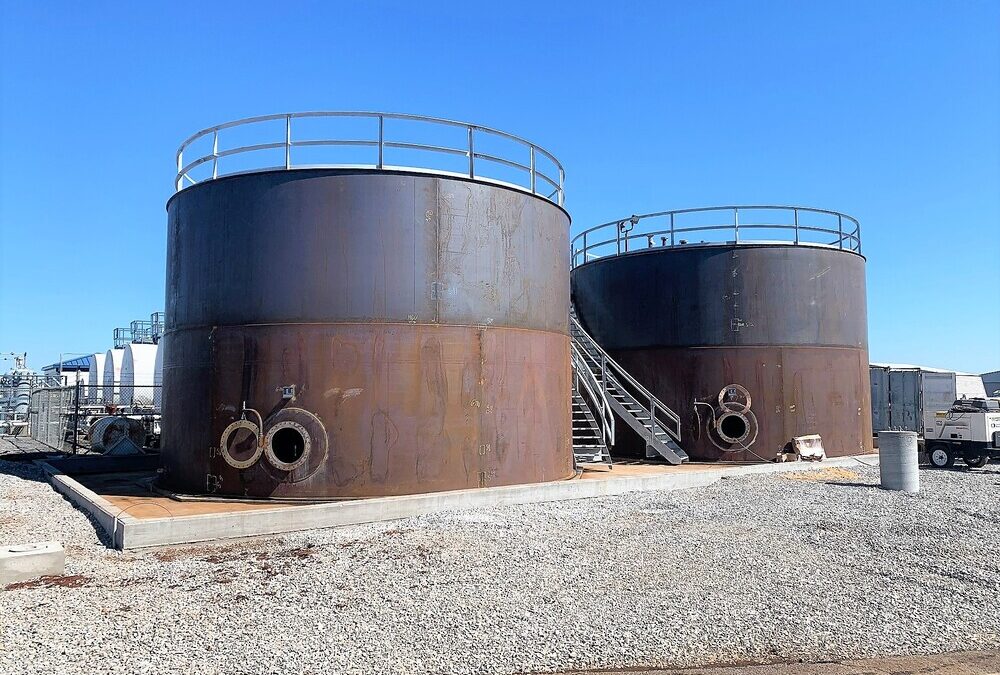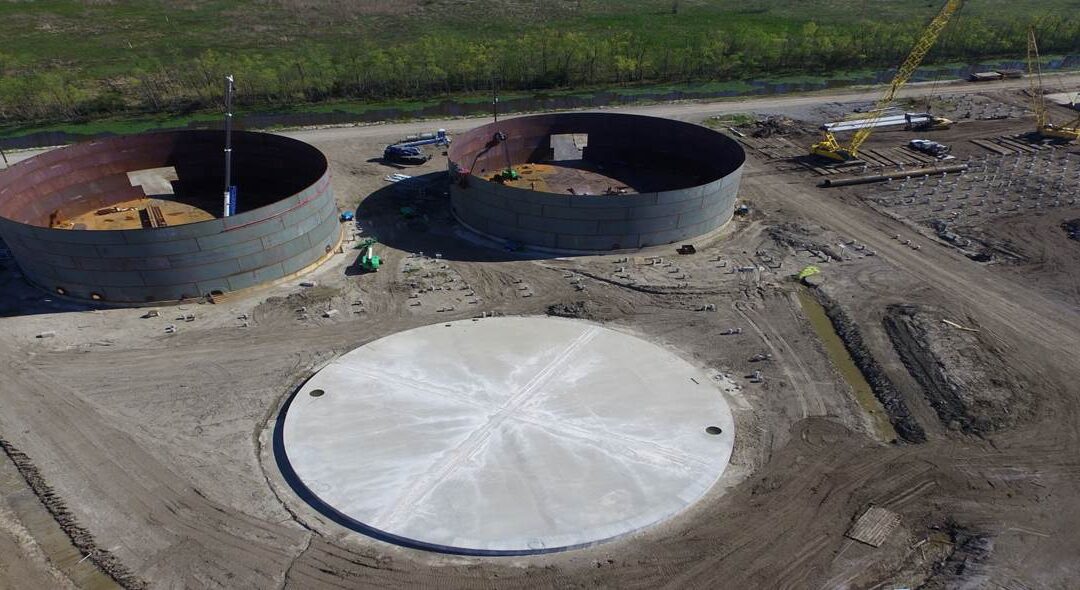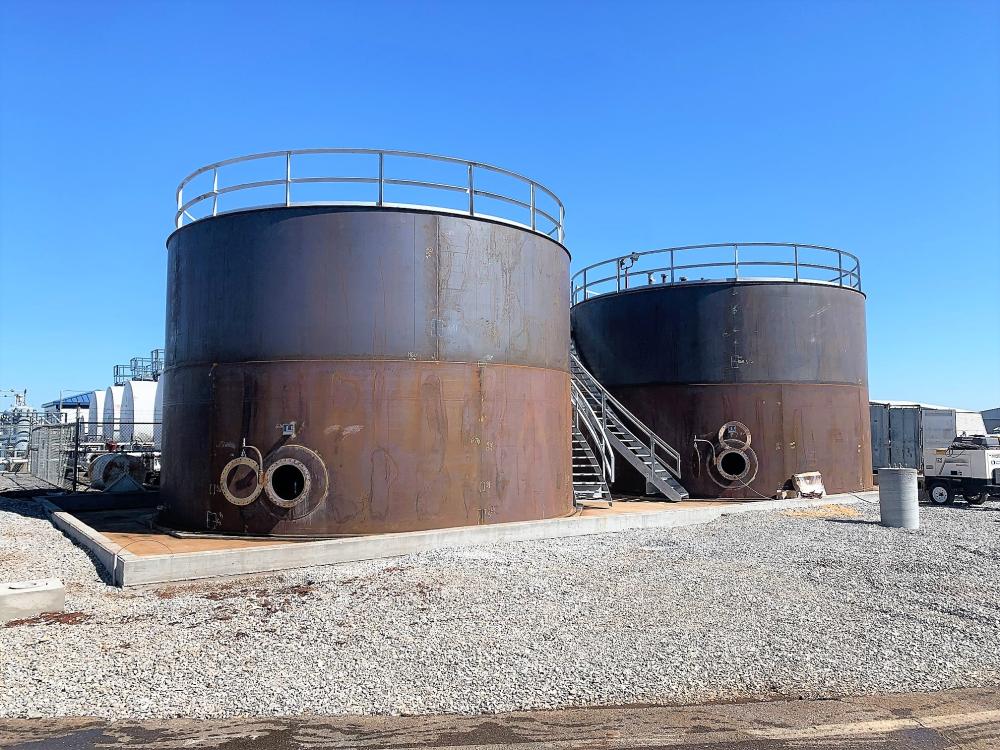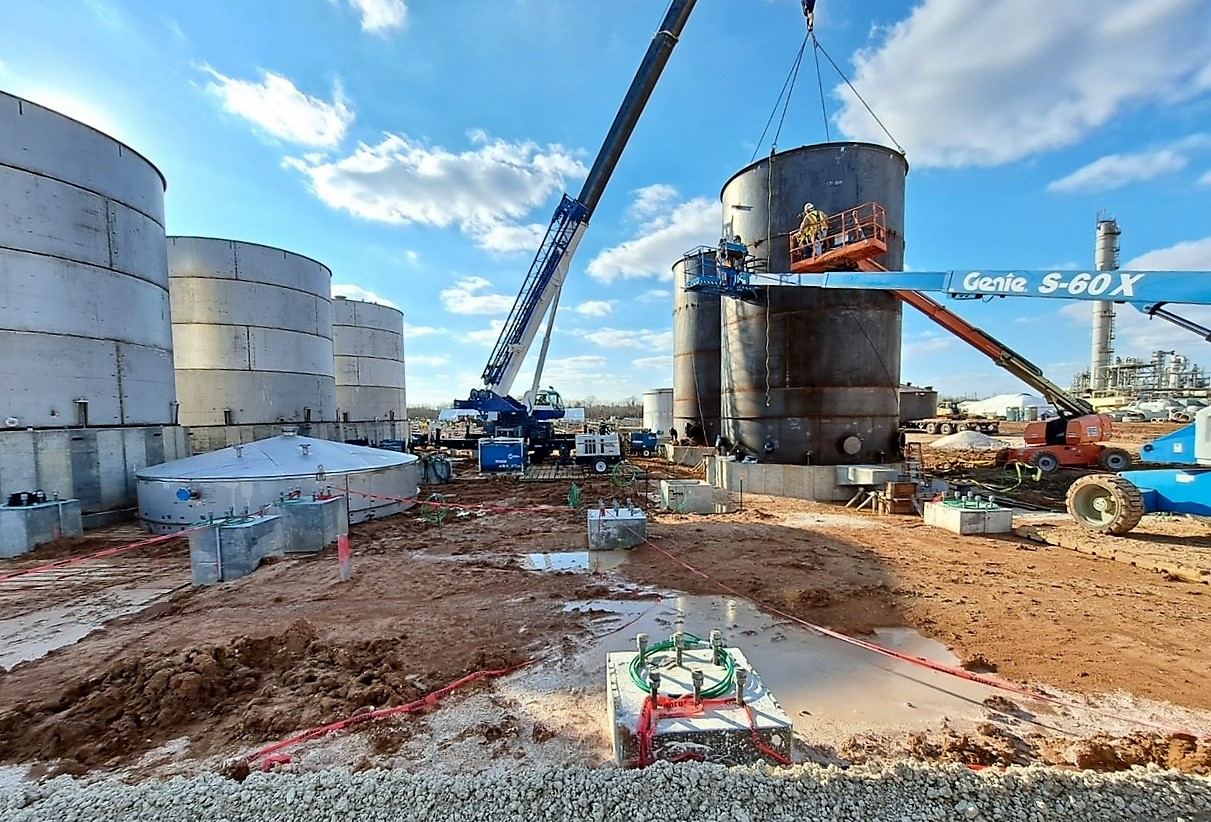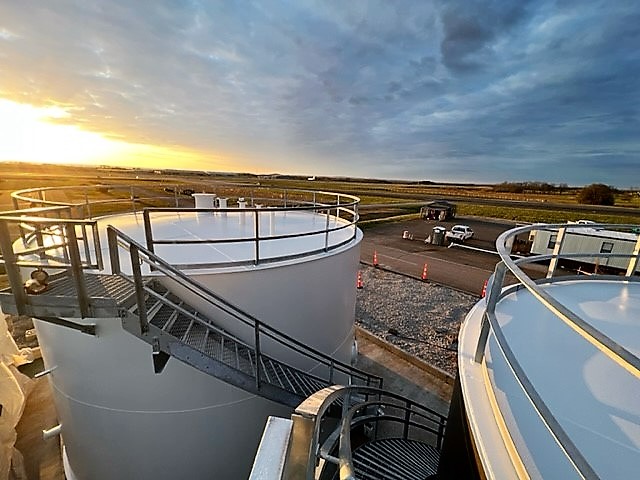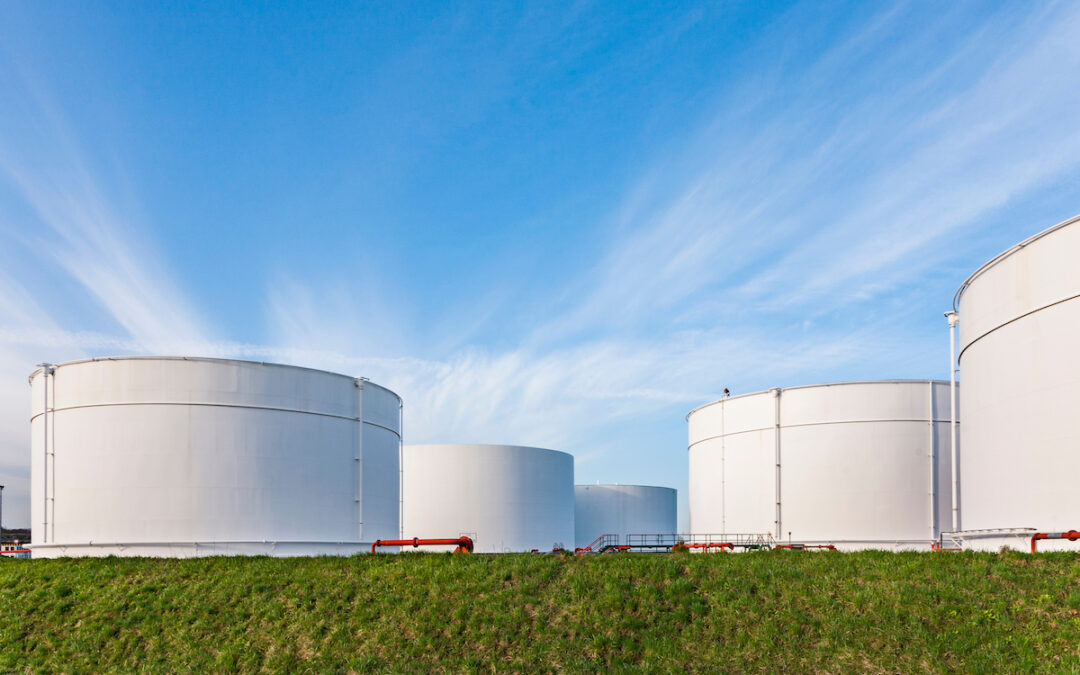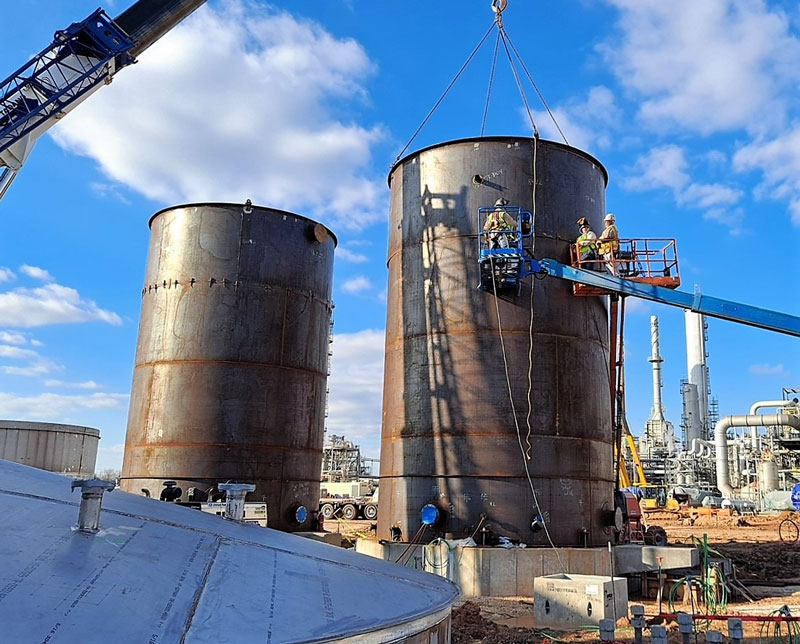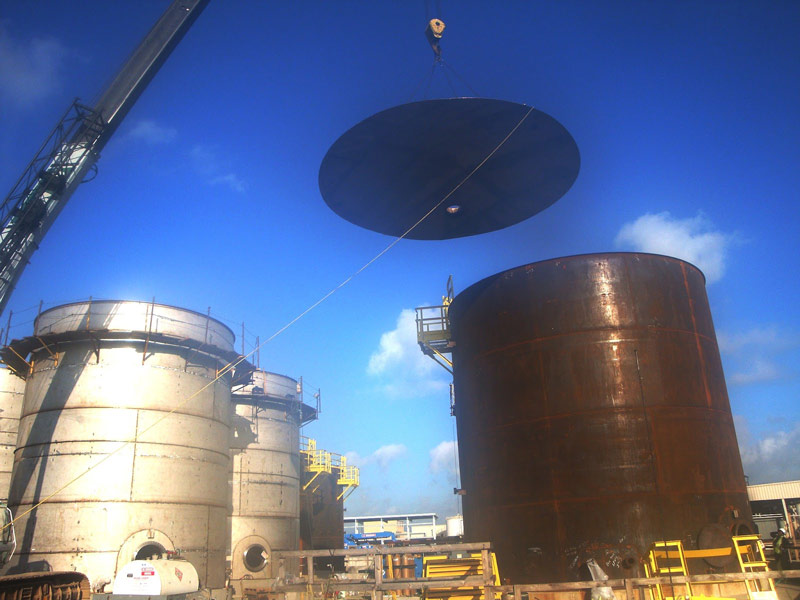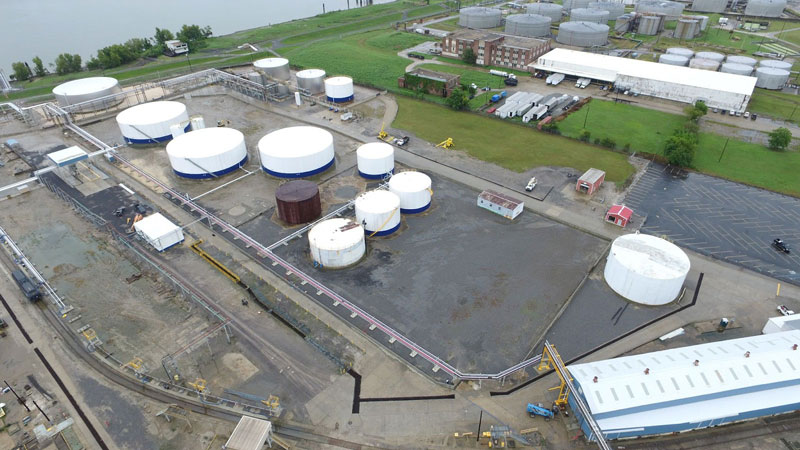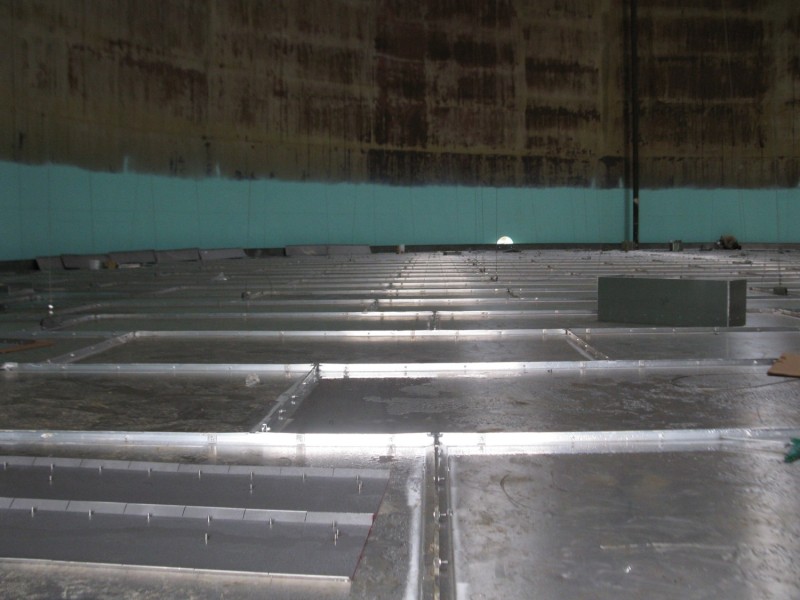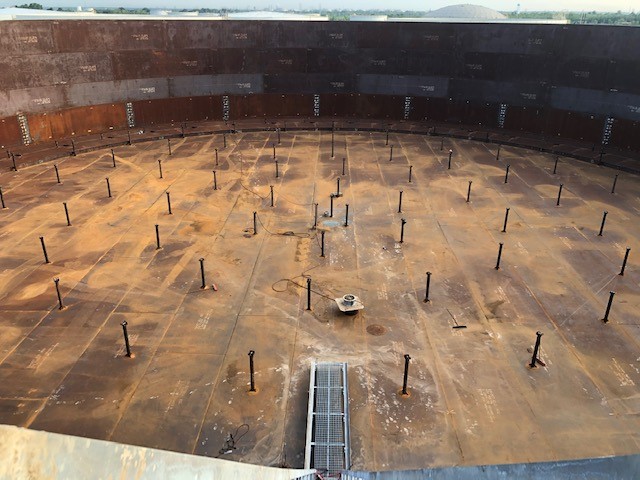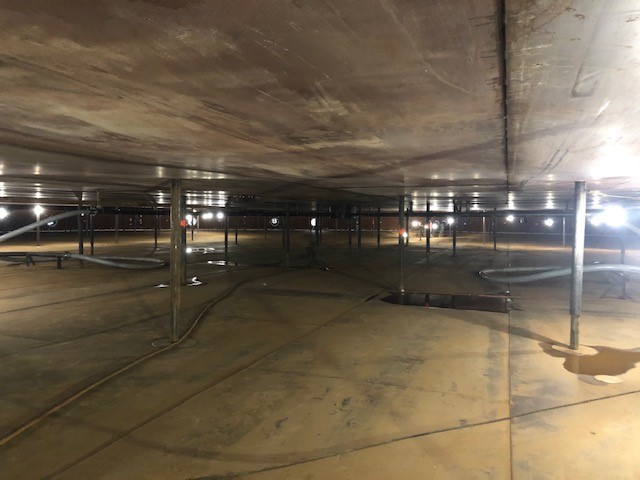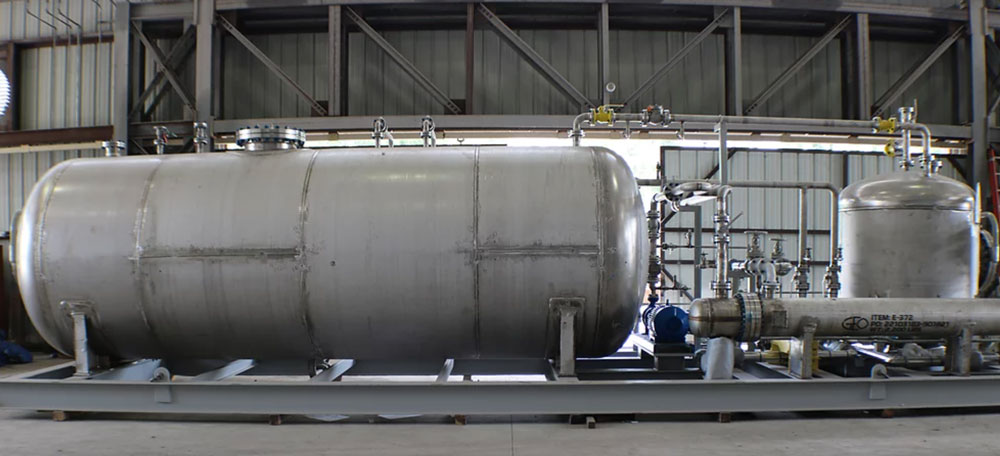
by PALA Group | Apr 27, 2023 | Storage Tanks
Aboveground storage tanks are designed to hold a variety of liquid or gaseous substances in bulk quantities, many of which are harmful to people, facilities, and/or ecosystems. To ensure safety for all, multiple agencies have established regulations specific to the design, build, and operation of aboveground storage tanks.
Below, we’ll take a look at the most important aboveground storage tank regulations to understand.
Aboveground Storage Tank Regulations — An Overview
There are hundreds of regulations out there related to aboveground storage tanks, about anything from design and build to inspection and maintenance. Since these structures often store hazardous materials (and lots of them), various agencies have joined the discussion and implemented guidelines around their use.
Here’s a list of some of the most prominent organizations that have created their own set of aboveground storage tank regulations. You can click on each to jump to their description in this article.
Aboveground Storage Tank Regulations by the EPA
If your facility has aboveground storage tanks that hold an oil of any kind, it may be subject to the EPA’s Spill Prevention, Control, and Countermeasure (SPCC) regulation: 40 CFR Part 112. While this regulation doesn’t specifically mention the term “aboveground storage tank,” it includes that term under the broader category of bulk storage containers.
SPCC helps prevent a discharge of oil from running into navigable waters or shorelines. It also ensures that every aboveground storage tank facility has a comprehensive response plan that prepares them in case of a spill emergency.
Aboveground Storage Tank Regulations by Local Governments
Aside from regulations established by the federal government (EPA), your local government and authorizing agencies may also have their own set of standards to follow. These will likely match federal regulations to an extent, but also have some more standards specific to the area and environment in which your facility is located.
This way, if your local environment is at risk of any specific threats or challenges, you and the people around you can be assured that you’re aware of them and have prepared for them properly.
Aboveground Storage Tank Regulations by Industry-Specific Agencies
There are a few industry-specific agencies that have created their own aboveground storage tank regulations based on their experience and expertise.
American Petroleum Institute (API)
API standards are specific to aboveground storage tanks that hold oil. There are three that are most applicable:
- API 620: tanks under pressure that are field-erected or repaired
- API 650: new tank construction
- API 653: tank repairs
Wondering how API 620 and API 650 differ, and which may be best suited for your application? Read this blog.
American Society of Mechanical Engineers (ASME)
ASME’s standards regulate the design, fabrication, and repair of aboveground storage tanks. Most importantly, they look closely at shop-fabricated tanks to ensure manufacturing processes and protocols are on track with best practices. This helps to ensure high-quality results, long-lasting solutions, and safety for all involved.
National Fire Protection Association (NFPA)
The NFPA regulates any aboveground storage tanks holding flammable liquids. They require that tanks are manufactured in compliance with the following standards:
- UL 142: tanks that store non-corrosive, stable flammable and combustible liquids with a specific gravity no greater than 1.0.
- UL 2085: tanks that must meet additional, specific design requirements to ensure a two-hour fire resistance and a secondary containment solution.
How Do I Know Which Regulations Apply to My Facility?
After reading through those aboveground storage tank regulations, you might wonder if they all apply to your facility or not. There are a few ways to find out.
First, you could conduct your own research by reading articles online, buying standards books, etc. This might also include asking colleagues that may have a better understanding of technical regulations.
Or, possibly a better option is to talk to an aboveground storage tank manufacturer in your area. They’ll be up to date on all the regulations, and how they’d apply to your location and project. Then, they can help you complete the project by designing, building, and maintaining an aboveground storage tank solution ideal for your application.
For Guaranteed Quality & Compliance, Choose PALA.
To ensure the safety of your people, facility, and environment, you must comply with the aboveground storage tank regulations in this article. At PALA, we can help you design, fabricate, and install an aboveground storage tank solution that complies, then maintain it, so it stays that way. For more information, don’t hesitate to give our team a call or contact us online.

by PALA Group | Oct 22, 2022 | Storage Tanks
Aboveground storage tanks are built to be incredibly durable, safely storing hazardous liquids and gasses for decades. However, there’s always a chance yours may need to be repaired.
Let’s talk about how to know when your aboveground storage tank needs repair, as well as some methods in which those repairs can be executed.
How Long Do Aboveground Storage Tanks Last?
Aboveground storage tanks last an average of 20 years. However, this can vary tremendously based on factors like:
- Tank fabrication material
- Tank fabrication method
- Substance(s) stored in the tank
- Tank special features
- Tank location
- Tank size
- Tank maintenance protocols
If your aboveground storage tank is built and maintained well, it should last those full 20 years or more. But even the highest-quality, most well-maintained tanks require repairs at some point.
4 Signs That Your Aboveground Storage Tank Needs Repair
It’s important to identify when your aboveground storage tank needs repair as soon as possible. Letting damage or inefficiencies go unnoticed for too long can result in disastrous, unsafe conditions for your people and the environment.
If you recognize that your aboveground storage tank shows any of the following signs, you should contact a repair technician for a professional inspection promptly.
1. Your Aboveground Storage Tank’s Legs Are Unstable
If your aboveground storage tank’s legs are wobbling, it’s not properly supported. This is a major issue when you consider how much weight those legs need to support — between the tank itself and the materials within it. Improper support can cause the tank to collapse or fall over, spilling its contents all over the surrounding area.
2. Your Aboveground Storage Tank’s Surface Is Deteriorating
You may be able to notice signs of tank deterioration by looking at it or by running your hand along its surface. The surface should be smooth and free of any bumps, dimples, divots, or rust.
If you do notice any imperfections in your tank’s surface, act immediately. Over time, those symptoms can worsen and turn into holes, which is an obvious problem.
3. Your Aboveground Storage Tank Is Leaking
Besides necessary vent lines, fill pipes, and exit pipes, your aboveground storage tank should be completely sealed. Make sure to check your tank’s surface, filters, and valves for a full inspection.
If you notice holes, drips, or leaks — even the smallest ones — your tank needs repair. A small drip today could be a full-blown spill tomorrow.
4. Your Aboveground Storage Tank Is Almost 20 Years Old
If your aboveground storage tank is approaching its 20-year average life expectancy, it’s a good idea to schedule an inspection — even if it’s not showing any of the signs mentioned above. When safety is a high priority, it’s important to be proactive.
Worst case scenario? You spent a few hours and a few hundred dollars to get peace of mind that your tank’s still functioning properly. Best case scenario? You find and fix an issue that wasn’t noticeable but could have caused hundreds of thousands of dollars in damage and severe personnel and environmental harm if left untreated.
How to Repair Your Aboveground Storage Tank
There are various methods of aboveground storage tank repair. As long as they comply with API standards and regulations, they’re viable for use. Some common ones include:
- Welding replacement steel plates onto the tank
- Filling tanks with fiberglass and coating them in resin and fabric
- Repairing holes with laminating epoxy and epoxy putty
- Inserting new liners and grout
Many of the traditional aboveground storage tank repair methods listed above involve difficult, time-consuming work. That’s why it’s important to get the repairs done right on the first try.
PALA’s 3D Laser Scanning Tank Services
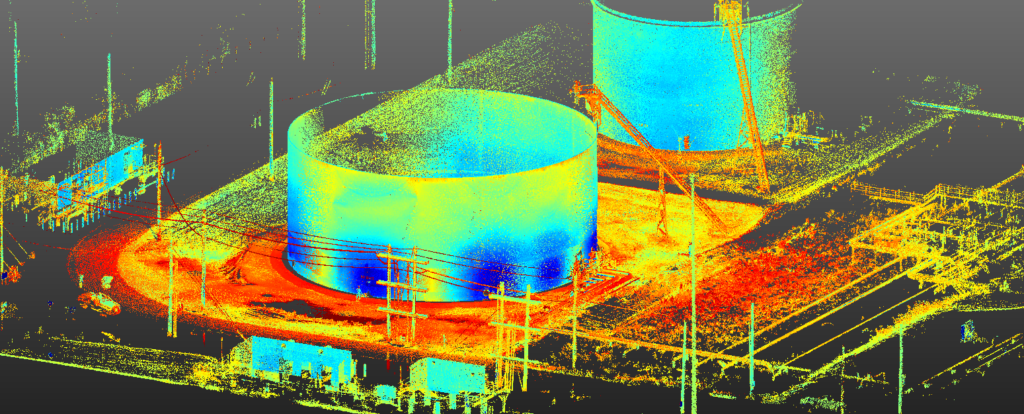
To ensure that aboveground storage tank repairs are done effectively and efficiently, PALA uses cutting-edge laser scanning technology from Novlum uniTank.
With this technology, we can conduct a comprehensive analysis and inspection within just a few hours, giving you real-time data to inform repair decisions. We can document existing tank conditions, perform fit-for-service studies, and use precise dimensional data for tank repairs, teardowns, and rebuilds.
It’s a fast, safe, and cost-effective option that sets the aboveground storage tank repair process up for success. Learn more about this 3D laser scanning technology and how it can benefit your application here.
Contact PALA For Your Aboveground Storage Tank Repair Needs
Aboveground storage tanks are durable, but they won’t last forever. If you notice something’s wrong with yours, it’s best to identify the problem and resolve it as quickly as possible. That’s what we’re here for.
PALA is your single source for comprehensive aboveground storage tank services. Using 3D laser scanning, we can ensure the safe storage of hazardous substances so you can keep your people, facility, and environment out of harm’s way. For more information on our aboveground storage tank repair capabilities, give our team a call or contact us online.

by PALA Group | Jun 12, 2022 | Storage Tanks
If you’re installing new aboveground storage tanks at your facility, you’ve probably heard that there are two main standards that regulate how storage tanks are built and designed: API 650 and API 620. But what is the difference? How do you know which is best for your application and industry?
There are many similarities and areas of overlap between the two standards. The differences between the two standards have to do with temperature, pressure, size, and the substance that will be contained in the storage tank. Read on to find out more about API Standard 650 and Standard 620 and how they differ.

Understanding API 650
API 650 Standard and Requirements
API Standard 650 defines the construction and design regulations for storage tanks that contain chemicals, oil, gas, biofuel, treated water, or other substances, with contents up to 2.5 PSI in pressure and between -40°F and 500°F design temperature. These tanks must be aboveground, cylindrical tanks with a fully, evenly supported tank bottom. They can have either open or closed-top designs and can be constructed from aluminum, carbon steel, or austenitic stainless steel.
To meet API 650 regulations, the tank must be constructed by a manufacturer bearing an American Society of Engineers (ASME) welding certification. While many API 650 tanks are field-erected, some based on diameter and height can be fabricated in-shop and shipped ready for installation.
If an existing API 650 or 620 storage tank needs inspection, repair, alteration or reconstruction, API 653 provides the guidance required. API 653 provides minimum requirements for maintaining the integrity of tanks after they have been placed in service.
Applications
- Oil and gas
- Biofuels
- Chemicals
- Water
Industries
- Energy
- Chemical
- Petrochemical
- Mining
- Agriculture
- Fertilizer
- Water treatment
- Manufacturing
- Food production

Understanding API 620
API 620 Standard and Requirements
API Standard 620 defines the appropriate design and construction of tanks with a diameter at or over 300 feet, and with contents up to 15 PSI in pressure and between -325°F and 250°F. This requires that compliant tanks be cylindrical, made of carbon steel, a low-temperature nickel alloy, or austenitic stainless steel, and revolve around a single vertical axis. The steel from which the tank is constructed must be at least 3/16 of an inch.
Like API 650, the 620 standard requires that the storage tank manufacturer have an ASME welding certification. Due to their large size, API 620 tanks are field-erected and repaired. While most of the inspection and testing requirements for API 620-compliant tanks are laid out in the standard itself, guidelines for performing a nondestructive examination of pressurized tanks are found in the ASME Boiler and Pressure Vessel Code, Article V.
Applications
- Cryogenic liquid
- Liquefied natural gas
- Low-temperature, high-pressure liquids, vapors, or gases
- Isolation tanks
Industries
- Metal processing
- Manufacturing
- Healthcare
- Food technology
- Electronics
- Semiconductors

What is the difference between API 650 and API 620 Standards?
To summarize the differences between these standards for storage tanks, API 650 deals with tanks of any size capable of withstanding higher temperatures at minimal pressure, whereas API 620 pertains to large, pressurized storage tanks containing materials at lower temperatures and can store any kind of liquid. API 650 tanks are not size restricted and are rated for higher temperatures, but lower pressures, and are used prolifically in oil and gas and chemical storage applications.
PALA is proud to manufacture aboveground storage tanks according to both API 650 and 620 tank standards, ensuring that no matter your application, our fabrication team can deliver the solution you need. For more information, give us a call or contact us online.

by PALA Group | May 22, 2022 | Storage Tanks
Aboveground storage tanks are used throughout industry and manufacturing, from agriculture to petrochemicals, from food production to mining. No matter your economic sector or application, if you have aboveground storage tanks, they’re vital to your organization’s efficient and successful operation.
Keeping those tanks functional and compliant with regulations is therefore essential to keeping things at your facility running smoothly. Since any tank that holds 55 gallons or more and is totally above ground is considered an aboveground storage tank (AST), it’s important that you know the rules and regulations that govern storage tank inspection.
What are the inspection requirements for aboveground storage tanks?
Per the EPA’s Spill Prevention, Control, and Countermeasure Plan (SPCC) Program, tanks must be tested regularly and when repairs are made. You are responsible for determining the necessary type and frequency of inspections, applicable industry standards, and the necessary qualifications of inspection personnel. Your determinations must account for the size of the containers, their design and construction, and their configuration.
Specific aboveground storage tank inspection requirements are set by industry standards. Two of the most common industry standards are published by the Steel Tank Institute (STI) and the American Petroleum Institute (API).
API Standard 653 Requirements
Large aboveground tanks must be inspected to meet API Standard 653, which governs tank inspection, repair, alteration, and reconstruction. API 653 covers aboveground steel storage tanks that adhere to the design specifications in API Standard 650 and API 12. The inspection components of the API 653 standard cover:
- General suitability for service evaluation
- Tank roof evaluation
- Tank shell evaluation
- Tank bottom evaluation
- Tank foundation evaluation
- Brittle fracture assessment procedure
- General inspection
- Inspection frequency
- External tank inspection
- Internal tank inspection
- Inspection checklists
- Inspection records
- Inspection reports
- Nondestructive examination (NDE)
STI SP001 Standard Requirements
STI SP001 Standard for the Inspection of Aboveground Storage Tanks is applicable primarily to metal, welded, shop-fabricated tanks, and field-erected tanks. This includes intermediate bulk containers, 55-gallon drums, and other small, portable containers, and does not include non-portable, shop-fabricated plastic or fiberglass tanks. It requires monthly, periodic inspections by the tank owner as well as formal internal and external inspections by a certified tank inspector.
Your organization’s SPCC Plan must indicate the standard to which your tanks will be inspected, and lay out your inspection frequency and procedures, as well as the qualifications of the personnel who will perform the inspections. Additionally, inspection records must be kept for at least three years, and the EPA recommends retaining these records for each container for the lifespan of said container.
How often should an aboveground storage tank be inspected?
Individual storage tanks should be inspected on a monthly basis, at minimum. They should also be inspected after repairs are made and after severe weather events. This inspection should check the tanks’ base, shell, interior walls, coating, containment ability, electrical components, insulation, and roof. Regular inspections help prevent and mitigate damage and leaks and can increase the life span of your ASTs.
Additionally, your Tank Arrangement Plan (TAP) for your aboveground storage tanks should be inspected and reassessed at least every five years.
What happens if your tanks don’t pass some part of the inspection?
If your ASTs fail any of the aboveground storage tank inspection requirements, the tank must be either decommissioned or repaired to serviceability per the regulations of the applicable industry standard. After repairs are made, the tank must be re-inspected to ensure serviceability before being used.
If your aboveground storage tank failed inspection because of a leak of oil, gasoline, chemicals, or other potentially hazardous substances, in addition to repairing or replacing the tank, you’ll need to ensure that your secondary containment measures effectively contained the spill. If not, you’ll need to report this spill to the EPA and perform any necessary mitigation.
How do you ensure your tanks are always in compliance?
Inspecting your tanks monthly, as suggested earlier, along with proactively performing required maintenance is an excellent start to ensuring that your aboveground storage tanks are always in compliance with aboveground storage tank inspection requirements. For industries with ASTs containing hazardous or volatile substances, ensuring that the secondary containment solutions are adequate and in good condition is another critical consideration.
Keeping thorough, accurate, and well-organized maintenance and inspection records for your storage tanks is another beneficial practice for maintaining tank compliance. Though it exceeds the requirement, keeping these records for the duration of a tank’s lifetime can be invaluable.
If your aboveground storage tank is in need of inspection, or has undergone inspection and came up lacking, PALA can help. From tank fabrication to repair, we have the tools and the team you need to ensure your tanks are safe and in compliance.

by PALA Group | Mar 21, 2022 | Storage Tanks
Fuel storage is a critical component of nearly every industrial enterprise, and it’s a complex one. Fuels can be flammable, combustible, and pressurized, as well as potentially pose health or environmental hazards. Regulation of fuel storage is necessarily stringent.
What this means is that well-functioning, well-maintained, and long-lasting fuel storage tanks are key to meeting regulatory requirements and maximizing your cost efficiency. Keep reading to learn the average life expectancy of aboveground fuel storage tanks, as well as how to ensure the optimal lifespan of your fuel storage tanks.
Average Life Expectancy of Aboveground Fuel Storage Tanks
On average, the life expectancy of aboveground fuel storage tanks and other aboveground storage tanks (ASTs) is about 20 years. This can vary based on the fabrication and materials, application, features, location, size, and maintenance of the storage tank. As you might expect, poorly maintained tanks may not last for 20 years, and well-maintained tanks may remain serviceable beyond this period.
Why the Life Expectancy of Your Aboveground Fuel Storage Tanks Matters to Your Facility
Fuel is essential to your operations, and so are the aboveground fuel tanks in which you store it. It’s crucial to maintain your storage tanks at their highest level of function to ensure smooth and efficient operations and to save money.
Planning, designing, and constructing aboveground tanks for fuel storage is not an inexpensive endeavor, nor is it quickly accomplished. It also carries a significant regulatory burden to ensure that tanks meet the appropriate API standards. To maximize cost efficiency, it’s important that you optimize the lifespan of your fuel storage tanks.
Knowing the expected lifetime of your fuel ASTs is also extremely useful for planning for the future and phasing outdated, poorly functioning equipment before a tank failure or before the cost of sub-optimal operation and extensive repairs and maintenance outpace the replacement cost of the fuel tank. Replacing a storage tank that experiences an unexpected catastrophic failure is a huge hit to your budget—for the replacement tank and mitigating any negative consequences. But the planned, budgeted-for replacement of an aging fuel storage tank won’t result in the same dent to your bottom line.
How to Achieve Optimal Life Expectancy for Aboveground Fuel Storage Tanks
Regular Inspections of Fuel Storage Tanks
Regular inspections are critical to keeping tanks in good repair and operating efficiently. If a stitch in time can save nine, an inspection is what informs you that the stitch is necessary, in time, before it causes noticeable problems for your operations.
Aboveground storage tank repairs and inspections must meet API Standard 653. This standard requires that the facility’s aboveground storage tank arrangement plan (TAP) be inspected and reassessed every five years, or when changes are made that affect the TAP. For ASTs with pressure vessels, inspections must also address compliance to API Standard 510.
Additionally, the aboveground tanks themselves should be inspected monthly, at minimum.
Tank inspections should assess:
- Tank structure
- Foundation
- Containment
- Insulation
- Electrical equipment
ASTs are prone to corrosion and weather damage, being above ground and exposed to the elements; this kind of damage can cause leaks, contamination, and myriad other issues that, if not addressed in time, can require extensive clean-up and repairs.
Older tanks that are nearing the end of their life expectancy should be assessed for their continued serviceability, tracking maintenance costs and operating costs. Tanks that require increasing maintenance, with increasing maintenance costs, may need to be reconstructed or phased out of use.
Aboveground Fuel Storage Tank Maintenance and Repairs
In every industry, facility, and application, in-use equipment will require regular maintenance and repairs, even under ideal operating conditions. This is especially true for equipment like aboveground fuel storage tanks, which have electrical equipment, may be pressurized, and can contain fuels that are considered hazardous substances.
Again, maintenance and repairs of ASTs must meet API Standard 653. Necessary maintenance can include liner installation, firewall repair, decommissioning, repairs to tank body or other components, and repairs or changes to internal and external piping. For pressurized fuel storage tanks, maintenance and repairs may also be needed for pressure vessels and spheres, in adherence with ASME Section VIII.
While you may be able to handle some of these maintenance activities in-house, it’s vital to have a relationship with a contractor who specializes in API- and ASME-compliant aboveground fuel storage tank maintenance and repair. This can help control costs and reduce tank downtime. PALA can include 3D Laser Scanning technology with inspections and repair to ensure you’re getting the accurate data you need to make the right decisions for your aboveground storage tanks.
With decades of experience in industrial fabrication, PALA can handle every element of design, fabrication, delivery, or even just on-site repairs, ensuring your facility gets a long-lasting aboveground storage tank that performs according to your application’s requirements. For more information about our services and capabilities, get in touch with our team today.

by PALA Group | Feb 21, 2022 | Storage Tanks
As a facility manager, you need to ensure that your facility has the reliable storage units it needs to safely store large quantities of product — especially if that product is capable of harming your personnel and environment.
One of the most popular ways to fulfill that need is through the use of aboveground storage tanks (ASTs). Below, we’ll walk through everything you need to know about aboveground storage tanks and how they can help you, FAQ-style.
What Are Aboveground Storage Tanks?
Aboveground storage tanks are large containers that rest on the ground’s surface. They’re designed to hold a variety of liquid or gaseous substances in bulk quantities, such as water, petroleum, gasoline, chemicals, and hazardous waste materials.
In order to ensure their ability to store potentially hazardous substances, above ground storage tanks are generally made of carbon steel, stainless steel and other durable alloys — some of the most durable materials out there. Additionally, these tanks usually have large storage capacities, with diameters up to 290’ and storage capacities up to 565,000 barrels (BBL).
What Do Aboveground Storage Tanks Look Like?
Most above ground storage tanks are made with the materials listed above and are sized depending on the needs of your facility. However, there are many different types of above ground storage tanks that you can choose from — all with a different style and appearance. Some of them include:
Fixed Roof Tanks
Designed with cone- or dome-shaped roofs permanently attached to their shells. There are a couple different types, including:
-
- Supported cone (structure)
- Self-supporting (no internal structure)
- Geodesic dome (aluminum)
Internal Floating Roof Tanks
Designed to float on top of the product, where the tanks are covered with fixed roofs. Types of these tanks include:
-
- Steel pan (cannot be used without a fixed roof)
- Steel pontoon
- Aluminum floating roof (full contact or pontoon-style)
External Floating Roof Tanks
Designed to float on top of the product. Types of these tanks include:
- Steel pontoon
- Aluminum floating roof
-
Horizontal Tanks
Generally a bit smaller in size and easier to move, and normally shop-fabricated.

What Is the Purpose of an Aboveground Storage Tank?
As mentioned, aboveground storage tanks have an important purpose in ensuring that a variety of potentially hazardous materials are stored safely. While these materials may be necessary for many industrial applications, they can pose a serious risk to the environment and overall health of the public if not kept securely. Aboveground storage tanks reduce those risks significantly.
What Qualifies as an Aboveground Storage Tank?
According to the Aboveground Petroleum Storage Act, a tank must meet the following qualifications to be deemed an above ground storage tank:
- Capacity to store 55 gallons or more
- Ability to store substances substantially or totally above the ground’s surface
Standards by Which Aboveground Storage Tanks Are Built or Repaired
There are a few standards and regulations that above ground storage tank manufacturers need to adhere to during the building or repairing processes. These are:
- API-650: new construction
- API-653: repairs
- API-620: tanks under pressure that are field erected or repaired
- ASME: shop-fabricated vessels
Are Aboveground Storage Tanks Pressurized or Non-Pressurized?
It depends. There are some above ground storage tanks that are made to store liquids or gases at pressures significantly different from normal air pressure. In many cases, these units have expandable vapor reservoirs that adjust to vapor volume oscillations caused by atmospheric temperature and pressure changes. This helps them maintain structural integrity, even when pressures are higher or lower than normal.
How Often Do Aboveground Storage Tanks Need to Be Inspected?
Your above ground storage tank arrangement plan (TAP) should be inspected and reassessed at least every five years. However, if any changes are made to your facility that impact the plan, it should be reassessed more frequently.
As for the aboveground storage tank itself, it should be thoroughly inspected on a regular basis (at least monthly) to ensure everything is working properly, no substances are leaked, and it’s on track to last as long as it should. If you’re not sure what to look for, here’s a checklist to reference:
- Any leaks or problems with the tank’s containment abilities
- Any threats to the strength of the tank’s base or foundation
- Any cracks, dents, corrosion, or bulging in the tank’s shell
- Any issues or failures within the tank’s electrical equipment
- Any depreciation or corrosion to the tank’s external coating
- Any cracks, dents, or accumulated water atop the tank’s roof
- Any moisture, mold, or impairment to the tank’s insulation
- Any cracks, dents, or contamination to the tank’s interior walls
Where you’re managing a tank farm or you’re looking for clarity on how to repair an existing aboveground storage tank, PALA is your expert source for industrial storage tank fabrication and repair. Give our team a call with any questions, or feel free to request a quote for service online today!
